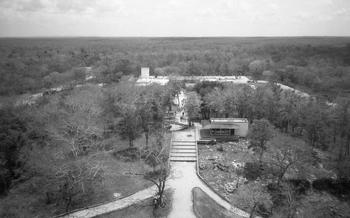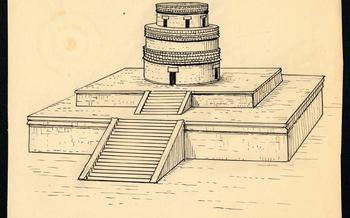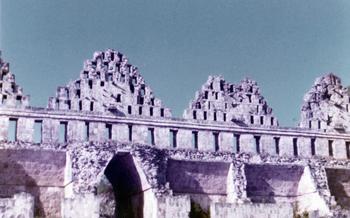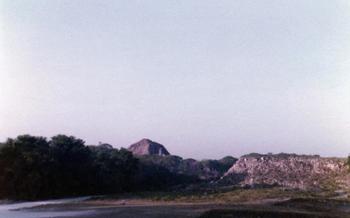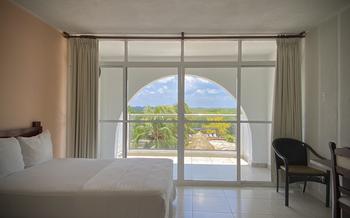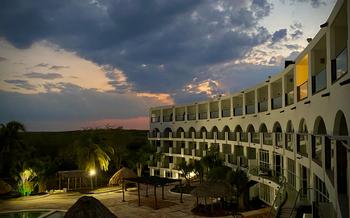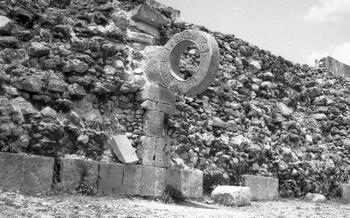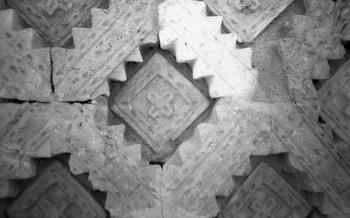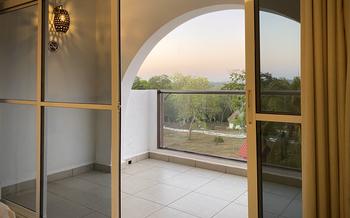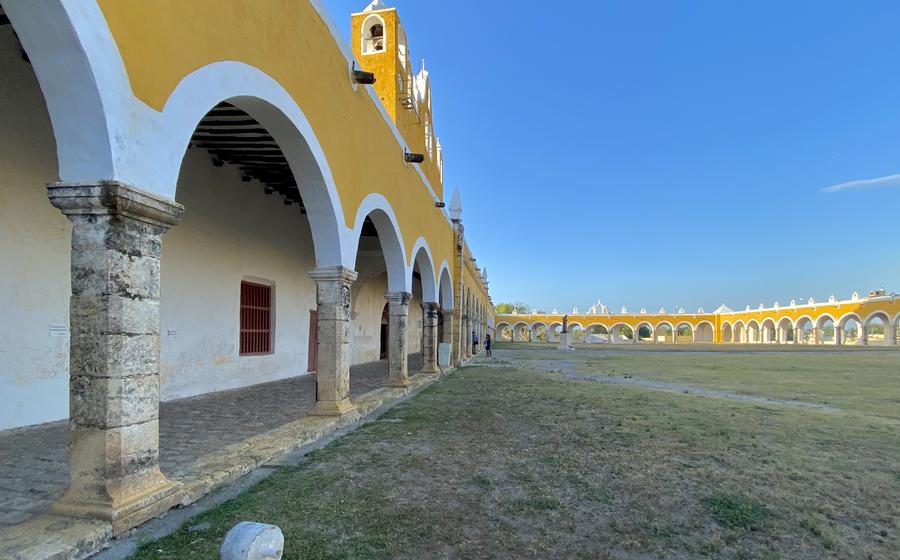
Puuc Route (Nearby city)
- The Magic of Izamal and the Puuc Route
- Strolling Through the Monastery of San Antonio de Padua
- Exploring the Ancient Mayan Ruins
- Uxmal - A Masterpiece of Mayan Architecture
- Kabah - The Temple of the Masks:
- Sayil - A Hidden Gem of the Puuc
- Labna - A Place of Arches and Palaces
- Xlapak - A Center of Ancient Astronomy
- Grutas de Loltún - An Underground Adventure
- Cenotes of the Puuc Region
- Mayan Cuisine and Gastronomic Delights
- Shopping for Local Crafts and Souvenirs
- Accommodations and Where to Stay
- Insider Tip: Hidden Gems and Secret Spots
The Magic of Izamal and the Puuc Route
Situated in the heart of the Yucatán Peninsula, Izamal proudly stands as a testament to the rich cultural heritage of Mexico. The city, bathed in a mesmerizing shade of yellow, was once a significant religious center for the ancient Maya and later transformed into a colonial gem under Spanish rule. The Puuc Route, a captivating circuit of ancient Mayan cities, lies in close proximity, showcasing architectural masterpieces that narrate the tales of a civilization that once flourished in this region.
Strolling Through the Monastery of San Antonio de Padua
The Monastery of San characterizes Izamal. Its imposing facade, adorned with intricate carvings and sculptures, reflects the grandeur of the Spanish colonial era. As you step through the arched entrance, the monastery's vast courtyard unfolds before you, surrounded by elegant arched corridors.
The story behind the construction of the monastery is as captivating as its architecture. Legend has it that a Mayan prince, Ah Kin Chel, had a vision of a Franciscan friar who instructed him to build a church on the site of an ancient Mayan temple. Ah Kin Chel, seeking to appease the gods and bring peace to his people, heeded the vision and initiated the construction of the monastery.
Inside the monastery, you'll find a treasure trove of architectural wonders. The vaulted ceilings, adorned with colorful frescoes depicting scenes from the Bible and Mayan mythology, are a testament to the artistic prowess of both cultures. The intricate carvings on the altars and pulpits showcase the fusion of Mayan and European motifs, creating a unique visual narrative.
Exploring the Ancient Mayan Ruins
The Puuc region is home to some of the most impressive and well-preserved Mayan ruins in the world. Uxmal, Kabah, Sayil, Labna, and Xlapak are just a few of the many ancient cities that dot the landscape. Each site has its own unique history, stories, and architectural wonders.
Uxmal, the largest and most famous city in the Puuc region, is a UNESCO World Heritage Site. It is known for its towering pyramids, intricate carvings, and sophisticated water management system. The Pyramid of the Magician is the most iconic structure at Uxmal, and it is one of the tallest and most impressive Mayan pyramids in existence.
Kabah is another important Mayan city in the Puuc region. It is known for its unique architectural style, which features rounded corners and intricate stone carvings. The most famous structure at Kabah is the Temple of the Masks, which is adorned with hundreds of stone masks. These masks are believed to represent the faces of Mayan gods and ancestors.
Sayil is a smaller and less-visited Mayan city in the Puuc region, but it is no less impressive. It is known for its well-preserved structures, which include a large pyramid, a palace, and a ball court. Sayil is a great place to visit for those who want to experience the Puuc region without the crowds.
Labna is another small Mayan city in the Puuc region, but it is home to some of the most unique and impressive architecture in the region. The most famous structure at Labna is the Arch of Labna, which is a large and intricately carved archway. Labna is also known for its palace complexes, which are some of the largest and most elaborate in the Mayan world.
Xlapak is a small and isolated Mayan city in the Puuc region, but it is one of the most important sites for Mayan astronomy. It is known for its structures that are aligned with celestial events, such as the equinoxes and solstices. Xlapak is a great place to visit for those who are interested in learning more about Mayan astronomy.
Uxmal - A Masterpiece of Mayan Architecture
Among the ancient Mayan cities that dot the Puuc region, Uxmal stands as a testament to the architectural prowess of this ancient civilization. This sprawling metropolis, once home to over 25,000 people, boasts some of the finest examples of Mayan architecture and is a must-see for any visitor to the region.
Uxmal's most iconic structure is undoubtedly the Pyramid of the Magician, a towering edifice that dominates the city's skyline. This awe-inspiring pyramid stands at an impressive height of 35 meters and is a testament to the engineering genius of the Maya. Its intricate carvings and symbolism provide a glimpse into the rich cultural and religious beliefs of this ancient civilization.
Beyond the Pyramid of the Magician, Uxmal is home to a wealth of other architectural wonders. The Nunnery Quadrangle, with its graceful arches and intricate friezes, is a masterpiece of design and craftsmanship. The Governor's Palace, with its elaborate facade and grand chambers, offers a glimpse into the life of Uxmal's elite.
A visit to Uxmal is a journey into the heart of the ancient Maya civilization. Here, visitors can marvel at the architectural achievements of this ingenious people and gain a deeper understanding of their rich cultural heritage.
Kabah - The Temple of the Masks:
Kabah, a remarkable ancient Mayan city located within the Puuc region, stands out for its unique architectural style, most notably the impressive facade of the Templo de las Máscaras, or Temple of the Masks. This iconic structure is adorned with hundreds of intricate stone masks, each representing a different human face. The masks are believed to have been used in religious ceremonies and rituals, and their enigmatic expressions have captivated visitors for centuries.
The Temple of the Masks is a testament to the extraordinary artistry and craftsmanship of the ancient Maya. The masks vary in size and design, with some depicting serene faces while others appear to convey emotions of joy, sorrow, or anger. The precision and detail in the carvings are simply astonishing and reflect the deep cultural and religious significance of the temple.
Beyond the Temple of the Masks, Kabah offers a wealth of other architectural wonders, including the Codz Poop, a palace featuring a series of vaulted chambers, and the Great Pyramid, which rises majestically above the surrounding landscape. The city's unique blend of architectural styles, from the Puuc to the Chenes, makes it a fascinating destination for anyone interested in Mayan history and culture.
When visiting Kabah, be sure to take the time to explore the surrounding area. The ruins of the ancient city are set amidst a lush tropical forest, providing a stunning backdrop for your explorations. Whether you're climbing the steep steps of the pyramids, marveling at the intricate carvings, or simply wandering through the overgrown ruins, Kabah is sure to leave a lasting impression.
Sayil - A Hidden Gem of the Puuc
Among the many wonders of the Puuc Route, Sayil stands out as a hidden gem, an off-the-beaten-path destination that offers a tranquil and immersive Mayan experience. While less famous than its counterparts, Sayil boasts well-preserved structures that showcase unique architectural features. The city's compact layout and intimate atmosphere invite visitors to wander through its ruins, discovering hidden corners and marveling at the intricate details that adorn its buildings.
One of the highlights of Sayil is the Great Palace, a massive structure that dominates the site. Its imposing facade features a series of elaborately carved doorways, each telling a different story from Mayan mythology. The palace's interior reveals a labyrinth of rooms and passageways, inviting visitors to explore the private chambers of the ancient Maya elite.
Another notable structure in Sayil is the Temple of the Masks, named for the numerous stone masks that adorn its exterior. These masks, each with a unique expression, are believed to represent different deities or ancestors. The temple's intricate carvings provide a glimpse into the religious beliefs and artistic prowess of the Maya.
Sayil's charm lies in its tranquility. Unlike the more popular sites on the Puuc Route, Sayil receives fewer visitors, allowing for a more intimate and personal experience. Here, travelers can wander through the ruins at their own pace, soaking in the atmosphere and connecting with the spirit of this ancient city.
Labna - A Place of Arches and Palaces
Labna, an ancient Mayan city located in the Puuc region, stands out for its unique architectural features, most notably the Arch of Labna. This impressive structure, one of the few remaining Mayan arches, showcases the advanced engineering and construction skills of the Maya. The archway, adorned with intricate carvings and symbolism, served as a ceremonial entrance to the city.
Beyond the arch, Labna boasts several well-preserved palace complexes, each consisting of multiple rooms arranged around central courtyards. These palaces, once the residences of the city's elite, showcase intricate stonework, decorative friezes, and elaborate doorways. The Palace of the Governor, the largest and most impressive of the complexes, features a unique corbelled vault ceiling and a series of beautifully preserved murals depicting scenes from Mayan life.
Labna's water management system is another remarkable feat of engineering. The city utilized a complex network of canals, reservoirs, and underground channels to collect and store rainwater during the dry season. This system not only ensured a reliable water supply for the city's inhabitants but also helped to irrigate the surrounding agricultural fields.
Visiting Labna offers a unique glimpse into the architectural ingenuity and advanced civilization of the ancient Maya. Its well-preserved ruins, including the iconic Arch of Labna, provide a tangible connection to the past and an opportunity to appreciate the enduring legacy of this remarkable culture.
Xlapak - A Center of Ancient Astronomy
Xlapak, an ancient Mayan city located in the Puuc region, holds a significant place in the history of astronomy. The city served as a center for astronomical observation and was home to skilled astronomers who studied the movements of celestial bodies. The alignment of structures within Xlapak with specific astronomical events, such as solstices and equinoxes, demonstrates the advanced knowledge and understanding of the Maya in this field.
The most notable feature of Xlapak is the Observatory, a small, circular structure with a narrow slit on one side. During specific times of the year, the sun's rays would pass through this slit and illuminate a marker inside the chamber, indicating the precise moment of the solstice or equinox. This accurate alignment required a deep understanding of solar movement and the Earth's position in relation to the sun.
The Observatory at Xlapak is a testament to the Maya's impressive astronomical prowess. It showcases their ability to observe and predict celestial events, which played a crucial role in their agricultural practices, religious rituals, and calendar system.
Grutas de Loltún - An Underground Adventure
Beneath the vibrant landscape of the Puuc region lies a hidden gem waiting to be explored – the Grutas de Loltún, an extensive system of underground caves that offers a captivating journey into the heart of the earth. These caves, formed over millions of years by the erosion of limestone, showcase stunning geological formations, including stalactites, stalagmites, and crystal-clear pools of water.
The history and legends surrounding the Grutas de Loltún add to their allure. Ancient Maya believed that these caves were sacred places connected to the underworld, and archaeological evidence suggests that they were used for ceremonial purposes. Local folklore and legends speak of hidden treasures and mystical creatures that reside within the depths of the caves, adding to their mystique.
Visitors to the Grutas de Loltún can embark on a guided tour, which typically involves walking through the main chambers of the caves, marveling at the impressive formations and learning about their geological and cultural significance. The caves are well-lit, making it easy to navigate and appreciate the intricate details of the rock formations.
For those seeking a more adventurous experience, spelunking expeditions can be arranged, allowing visitors to explore deeper into the cave system, crawl through narrow passages, and witness hidden chambers that are not accessible on the standard tour. These expeditions require specialized equipment and are led by experienced guides who ensure the safety and well-being of participants.
Whether you choose to take a leisurely guided tour or embark on a thrilling spelunking adventure, the Grutas de Loltún offer a unique and unforgettable experience that combines natural beauty, cultural history, and a touch of mystery.
Cenotes of the Puuc Region
The Puuc region is home to a wealth of cenotes, natural sinkholes that expose the underlying groundwater table. These cenotes were considered sacred by the ancient Maya, who believed they were portals to the underworld. Today, visitors can swim, snorkel, and dive in these refreshing, crystal-clear waters, surrounded by lush vegetation and dramatic rock formations.
Some of the most popular cenotes in the Puuc region include Cenote Suytun, a deep, crystal-clear cenote with a wooden platform and ladder for easy access; Cenote Xlacah, a large cenote with a cave system that can be explored by snorkelers; and Cenote Ik Kil, a stunning cenote located within the Chichén Itzá archaeological site.
Mayan Cuisine and Gastronomic Delights
Indulge in the flavors of the ancient Maya as you embark on a culinary journey through Izamal and the Puuc Route.
Taste the aromatic cochinita pibil, a tender pork dish slow-cooked in banana leaves with achiote paste and spices, a legacy of the ancient Maya. Delight in panuchos, a traditional open-faced sandwich filled with refried beans, cochinita pibil, and pickled onions. Savor the flavorful poc chuc, grilled pork marinated in citrus and spices.
Embark on a culinary adventure that will tantalize your taste buds and transport you back in time.
Corn, beans, and chili peppers, the holy trinity of Mayan cuisine, form the foundation of many dishes. Savor the simplicity of fresh tortillas, handmade with love and served warm. Sip on refreshing horchata, a sweet and creamy beverage made with rice, cinnamon, and sugar. Indulge in the decadent Marquesitas, crispy crepes filled with a variety of sweet or savory fillings.
Immerse yourself in the rich culinary heritage of the Maya, where flavors and traditions intertwine to create a gastronomic symphony.
Shopping for Local Crafts and Souvenirs
The Puuc region is a treasure trove of traditional crafts and souvenirs, reflecting the rich cultural heritage of the Maya. Vibrant markets and shops line the streets of Izamal and the surrounding towns, offering a kaleidoscope of handmade goods that showcase the creativity and skill of local artisans. From intricate textiles and pottery to colorful embroidery and woven baskets, there is something for every taste and budget.
One of the most popular souvenirs is the huipil, a traditional Mayan blouse adorned with vibrant embroidery. Each huipil is unique, as the patterns and colors vary depending on the village where it is made. Another must-buy is the hamaca, a handwoven hammock, perfect for relaxing in the warm Yucatecan breeze.
For those seeking one-of-a-kind pieces, the ceramics of Ticul are a must-see. These intricately painted pottery items, ranging from plates and bowls to decorative figurines, are crafted using ancient Mayan techniques that have been passed down through generations.
Shopping for local crafts and souvenirs is not just about acquiring beautiful items; it's also a way to support the local economy and preserve cultural traditions. By purchasing handmade goods, you directly contribute to the livelihood of skilled artisans and help ensure that their unique skills continue to thrive.
Accommodations and Where to Stay
Izamal and the surrounding Puuc region offer a diverse range of accommodations to suit every traveler's needs and budget. From budget-friendly hostels and guesthouses to mid-range hotels and luxurious haciendas, there is something for everyone. For those seeking a truly unique experience, consider staying in a traditional Mayan village or a restored colonial-era mansion.
To immerse yourself in the local culture, opt for a homestay with a Mayan family. This is a fantastic opportunity to learn about Mayan traditions and customs while enjoying home-cooked meals and personalized recommendations for exploring the region.
For those seeking comfort and convenience, there are several modern hotels in Izamal and nearby cities. These hotels offer amenities such as swimming pools, restaurants, and tour desks. It's advisable to book your accommodation in advance, especially during peak tourist seasons, to secure the best rates and availability.
Here are some insider tips for finding the best deals on accommodations:
- Check online travel agencies and comparison websites to compare prices and read reviews from previous guests.
- Consider staying in nearby towns such as Valladolid or Merida, which offer a wider range of accommodation options and lower prices.
- Take advantage of discounts and promotions offered by hotels and hostels, especially during the shoulder seasons (May-June and September-October).
- If you're traveling in a group or for an extended period, consider negotiating for group rates or long-stay discounts.
Insider Tip: Hidden Gems and Secret Spots
Beyond the popular tourist attractions, the Puuc Route holds a treasure trove of hidden gems and secret spots waiting to be discovered. For a truly immersive experience, venture off the beaten path and explore these lesser-known destinations.
One such hidden gem is the small village of Ek Balam, home to impressive Mayan ruins that rival those of Chichén Itzá in grandeur. As you climb the steep steps of the main pyramid, you'll be rewarded with breathtaking views of the surrounding jungle.
Another secret spot is the Cenote X'keken, a secluded and pristine cenote surrounded by lush vegetation. Take a refreshing dip in its crystal-clear waters and enjoy the tranquility of this hidden oasis.
For a unique experience, consider visiting the Loltún Caves during the full moon. The moon's light illuminates the intricate cave formations, creating a magical and ethereal atmosphere.
To avoid the crowds, plan your visit to the Puuc Route during the shoulder season (May-June and September-October). This way, you can enjoy a more intimate and authentic experience of this captivating region.
Insider Tip:
- Engage with local guides to discover hidden cenotes and caves known only to the locals.
- Visit the Puuc Route during the rainy season (June-August) to witness the lush greenery and cascading waterfalls.
- Learn a few Mayan phrases to connect with the locals and gain a deeper understanding of their culture.

